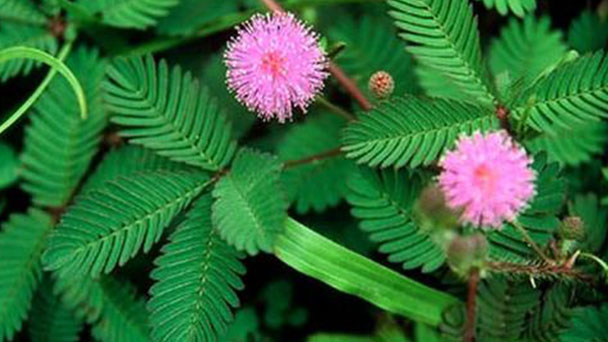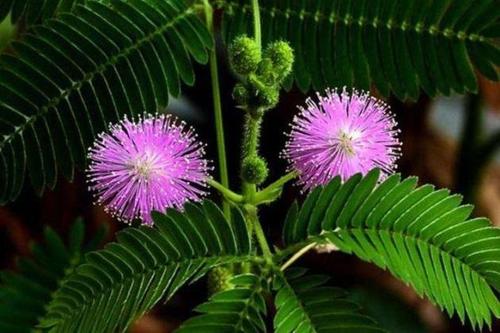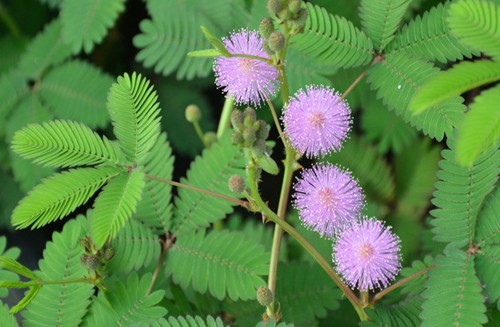Shameplant profile
Written by Maggie
Mar 31 2021

Shameplant, scientific name Mimosa Pudica, is shaped like a pompon. After flowering the pod, the fruit was oblate round. Leaves are feathery compound leaves alternate, palmately arranged. Flowers about after midsummer, capitulate oblong, 2-3 born in leaf axils. Flowers are white, pink, calyx campanulate, have 8 minute calyx teeth, petals four lobed, stamens four, ovary glabrous. Pod is flat, each pod has 1 seed, falling off between the mature seasons. The flowers, leaves and pods of Shameplant have good ornamental effect and are easier to survive, which is suitable for potted flowers on the balcony and indoors (people eating or excessive contact with Shameplant will also cause hair shedding). They can also be planted in places like courtyards.
Shameplant picture

Shameplant characteris
Stems of shameplant are up to 1 m high, branches near tendrillike, often greenish purple, precisely hairy, stems and nodes with sharp spines.
Leaves: Opposite leaves, bipinnate compound leaves, long stalks, stalks 1.5 -- 4 cm long; Stipules are lanceolate, 0.4 -- 1 cm long, bristles, pinnacles 2 -- 4, leaflets opposite, 10 -- 20 pairs, linear oblong, 0.8 -- 1.3 cm long, apex acute, base subrounded, slightly oblique, margin purplish sparsely bristled, fingerlike arranged at the top of the total petiole.
Flowers: capitulate with long pedunculate; Single or 2~3 in leaf axils; Diameter is approx. 1 cm; The flowers are small and reddish;Bracts linear, margin bristly; Calyx is funnelform, minute, short teeth parted; Corolla is campanulate, distally 4-lobed, lobes triangular, outside pubescent; shameplant has 4 stamens, base connate, extruding outside petals; Ovary is short stipitate, glabrous, style filiform, stigma small. Flowering period is in summer and autumn.
Fruit: The pod is flat and curved, about 1.4cm long, with a beak at the apex and 3-4 segments, each segment having 1 seed. The margin of the pod is undulate, spiculate, and the segments fall off when mature. Seeds are broadly ovate. Fruit stage is from April to November.
Shameplant Origin
Shameplant is native to tropical South America. Introduced to Taiwan by the Dutch in 1645.
Shameplant growth habits
Originated in the tropical regions of America, Shameplant is now widely distributed in the tropical regions of the world. Shameplant is produced in Taiwan, Fujian, Guangdong, Guangxi, Yunnan and other places. Born in the wilderness wasteland, shrubs, often cultivated in the Yangtze River basin for ornamental. Shameplant likes a warm, wet and sunny environment, suitable for sandy loam with good drainage and rich organic matter, with robust plants, rapid growth and strong adaptability.

Shameplant growing methods
Need frequent watering: Shameplant is a kind of plant that lives in the tropics and likes wet flowers and plants, so keep moisture in the pot soil often and keep the pot soil wet and not too dry; Hot summer weather, we should pay attention to observe the actual situation of watering, watering about 1 times a day, do not let the pot soil dry, always spray water to the plant, prevent the plant water loss too fast, and even dry; Winter watering to reduce the amount of watering, watering as little as possible, otherwise easy to occur freezing damage.
The selection of soil is Shameplant: the requirement of soil is not high, and only ordinary garden soil is needed for planting. If conditions permit, it is best to choose some loose and fertile mixed soil with humus, of course, only leaf rot soil or sandy soil is also acceptable.
Keep adequate light: the plant is Shameplant that is happy with light, so it is best to place it on the windowsill or balcony with sunshine. The sunlight is conducive to the growth of the plant, and if the sunlight is too little, it will stop growing, yellow and wither.
The Shameplant flower language
Shy, sensitive, polite
The leaves of the Shameplant will be huddled up if they are touched with hands, watered or in a typhoon.It's like bowing to someone.It's a very polite plant. Therefore, its flower language is "politeness". Whoever is born of the flower's blessing is one who is well-behaved and popular with the elderly. But it makes your peers feel afraid, so you should relax yourself once in a while, because too serious rules, even the opposite sex will be afraid to get close.

Latest Updated
- Benefits of Bugleweed - 7 Science-backed Health Benefits
- Bugleweed Dangers & Side Effects - Is It Poisonous?
- How to Plant Evergreen Trees - What You Should Know
- When to Plant Evergreens - Grow Guide for Evergreen Trees
- 12 Wonderful Evergreen Shrubs for Your Garden
- 12 Popular Evergreen Plants with Pictures for Beginners
- When And How To Prune A Lilac Bush Like a Pro
- How to Grow & Care for Lilac Vine (Hardenbergia Violacea)
- Japanese Lilac Tree (Syringa Reticulata) Care & Propagation Guide
- Shumard Oak Pros and Cons - What to Know
Popular Articles
- Winter maintenance of Antirrhinum Majus
- How to Grow Terminalia Mantaly Tree
- How to Grow and Care for Crossostephium Chinense
- How to grow Antirrhinum Majus in spring
- Peristeria Elata (Dove Orchid) Profile: Info & Care Guide
- Underwatered Snake Plant (Sansevieria Trifasciata) - Signs And How To Fix
- How to Care for Brazilian Jasmine Plant (Mandevilla Sanderi)
- How to Grow & Care for Graptopetalum Purple Delight in Summer
- Rosa Chinensis (China Rose): Plant Growing & Care Tips
- How to Care for Baby Sun Rose (Aptenia Cordifolia)